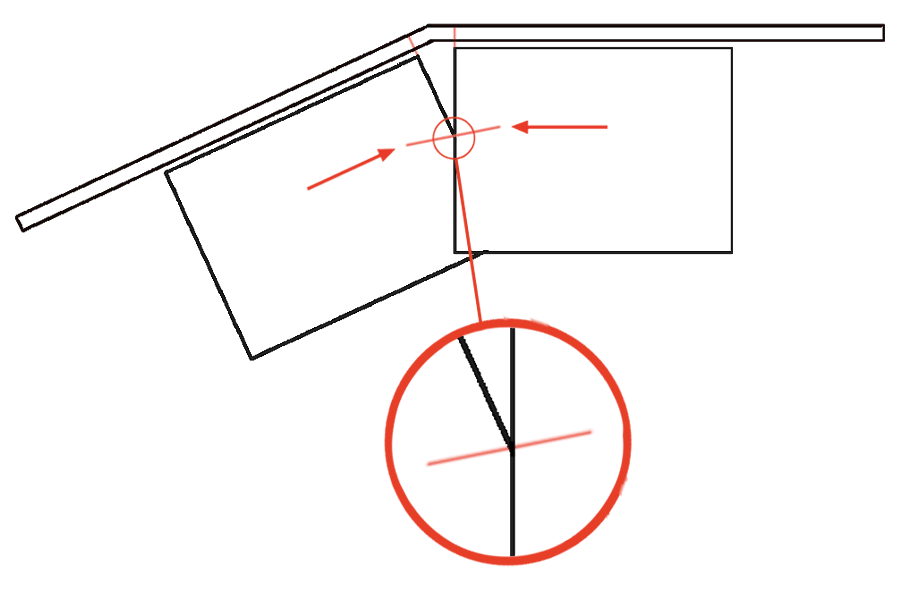How to Measure a Bay Window for Blinds
If you’re looking to fit your blinds within a bay window, it’s important to first know which type of bay you have; box or angled. This will determine which measuring method you will use.
A box bay window is rectangular in shape and generally features one central window with two or more windows that are squared at either side. If the side windows of the bay window come in at an angle instead, then this is known as an angled bay. Once you’ve determined which style of bay window you have, simply select the correct method below to measure for your blinds.
- How to Measure for Blinds in a Box Bay Window
- How to Measure for Blinds in an Angled Bay Window
- Headrail Depths
Please Note: TwistFit Blinds are not suitable for bay windows.
How to Measure a Box Bay Window
If you’re measuring a box bay window, there are a few different options on how you can measure. The option you use will depend on the type of blinds you choose and/or the size of your window.
Measuring the Width – Option 1

Simple and straightforward, this is the most common way to measure and install your blinds in a bay window. As shown in the image above, you will have one blind that runs across the front of your window from corner to corner. This is then paired with two more blinds for each of your side windows. These blinds are installed right next to the headrail of your first blind.
To measure for your first blind that goes across the width of your window, you should measure the full width of the bay from side to side and order this as a ‘recess fit’. Next, to measure your side windows you should measure from the outer edge of the window going inwards into your bay. Measure from left to right and make sure to take measurements for each of your side windows individually as they can differ ever so slightly. Once you have measured your side window, you should then deduct the size of your rail depth and order each side window blind as ‘exact fit’. This will stop your blinds obstructing each other when they’re all fitted within your bay.
Your headrail depth will vary depending on what blind type you have chosen. Please find the relevant depth for your chosen blind in the table at the bottom of this page.
Please Note: If you have any obstructions protruding from your main window, you should measure how far these stick out past the window frame. This should then be deducted from the width of each of your side blinds.
Measuring the Width – Option 2

Offering a professional finish, this option has all 3 blinds meeting at the corners of your bay window without overlapping. Here, you will need to first ensure your box-bay is suitable for this style of fitting. You can do this by checking the side of your window frame, starting in the corners. Measure from the corner of your bay to the start of the glass pane on your main window and side windows. If either measure less than your headrail depth, then you should opt for option 1 or 3.
If you have adequate space, then you can begin measuring your width. Using a measuring tape, simply measure your main window from side to side, and then measure each of your side windows the same way. Once you have your width measurements for each window, you should deduct the headrail depth from each of them. All 3 blinds should then be ordered as ‘exact fit’. We recommend this option for vertical blinds as there is less chance of the vanes clashing.
Please Note: Obstructions on your main window will reduce the width of the side blinds while obstructions on the side windows will reduce the width of your main blind. If you have any obstructions protruding from any windows, you should measure how far these stick out past the window frame. This should then be deducted from the width of the affected blind.
Measuring the Width – Option 3

Suitable for even the smallest of box bay windows, this option has your two side blinds continuing right into the corner of your bay window, with your main blind fitting snugly between them.
Here you should start by measuring the width of each of your side windows. Measure from the outer edge of the side window, right into the inner corner, making sure to take 2 separate measurements for each window. These should then be ordered as ‘recess fit’. You can then measure for your main window by measuring from corner to corner. It’s important here to then deduct double the headrail depth from your width measurement to account for the 2 side blinds. For example, if your headrail depth is 70mm, you should deduct 140mm from your main blind, and then order this as ‘exact fit’.
Please Note: Obstructions on your side windows will affect your measurements. If you have any obstructions protruding from the window, you should measure how far these stick out past the window frame and deduct this from the width of your main blind. Keep in mind that if there is an obstruction on both side windows, you will need to deduct this from the main blind width twice.
Measuring the Drop
Once you’ve measured the width of your box bay, it’s time to measure your drop. This is measured the same way for all the options above. Simply measure from where the blind will be mounted (usually within the window recess), down to the windowsill. Remember that the headrail is included in the drop of your finished blinds, and you’ll need around 5cm of space to mount your brackets securely. Once you’ve measured the width of your box bay, it’s time to measure your drop. This is measured the same way for all the options above. Simply measure from where the blind will be mounted (usually within the window recess), down to the windowsill. Remember that the headrail is included in the drop of your finished blinds, and you’ll need around 5cm of space to mount your brackets securely.
IMPORTANT! Please note, if you are ordering vertical blinds, any recess blinds within your order will have 10mm deducted from the drop to allow your blinds to fit within the window recess. You should make relevant adjustments to any ‘exact fit’ blinds on your order to ensure all blinds ordered arrive the same size. For exact fit blinds ONLY, please deduct 10mm from your drop measurement.
Check 3 Times
As our blinds are all fully made to measure, we always recommend that you check your widths in 3 different places across your window. This is particularly important when it comes to measuring blind for a bay window as they are often prone to movement and you may find that even if at first glance your window looks even, it can often vary by a few mm or cm. For any window measurement, you should measure first across the top of the window, then the middle, followed by the bottom. Make sure to then use whichever width measurement is smallest.
How to Measure an Angled Bay Window
Before you begin measuring for your blinds, you’ll need to know the headrail depth of your chosen blind type. This can be found in the handy table at the bottom of the page. It’s also important to note any obstruction such as handles or vents that may stick out of your window frame. You’ll need to measure how far past the window frame these protrude and add this onto your headrail depth. For example, if your headrail depth is 70mm and your window handle protrudes outside the window frame by 5mm, you should add these together for a measurement of 75mm. This will be used as your ‘A’ measurement.

Step 1
Using two pieces of straight edged paper, place them edge to edge and mark them at the required A measurement (your headrail depth plus any obstructions).

Step 2
Take your two marked pieces of paper and slide them towards each other along the windowsill of the bay until the two marks on either piece line up.

Step 3
Using a pencil, lightly mark the area where the paper meets the window frame. Repeat this step for each corner within your angled bay.

Step 4
Once you have marked your windowsill, measure from one mark to the next as detailed above. This will establish the width of each blind you need to order.
Step 5
To measure the drop, simply start at the top of your window down to where you want the blind to end (typically the windowsill). All blinds can then be ordered as ‘exact fit’.
IMPORTANT! Please note, if you are ordering exact fit vertical blinds, we recommend deducting 10mm from your windows drop measurement to ensure adequate clearance for the slats.
Headrail Depths
Use the table below to find the headrail depth for your chosen blind type, you’ll need this to make amendments to your measurements.
| Blind Type | Headrail Depth |
|---|---|
| 35mm Wooden Blind | 65mm |
| 50mm Wooden Blind | 75mm |
| 25mm Aluminium Venetian Blind | 30mm |
| 35mm Aluminium Venetian Blind | 37mm |
| 50mm Aluminium Venetian Blind | 51mm |
| Roller Blind with Top Fix Bracket | 50mm (up to 2m wide), 70mm (over 2m wide) |
| Roller Blind with Face Fix Bracket | 60mm (up to 2m wide), 80mm (over 2m wide) |
| Vertical Blind | 75mm |
| Roman Blind | 45mm |
| Rigid PVC Vertical Blind | 75mm |
 White
White Blue
Blue Grey
Grey Green
Green Black
Black Pink
Pink Natural
Natural Purple
Purple Cream
Cream Orange
Orange Brown
Brown Red
Red Silver
Silver Gold
Gold
 Your Samples
Your Samples